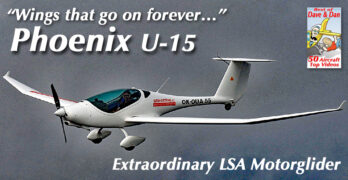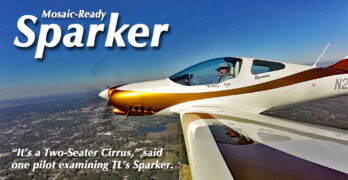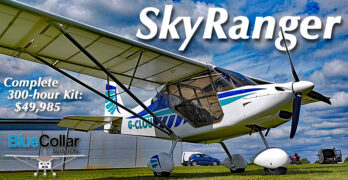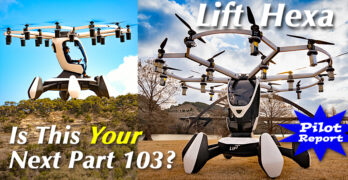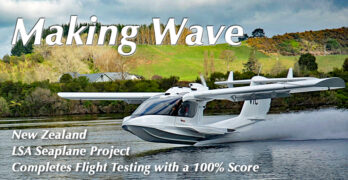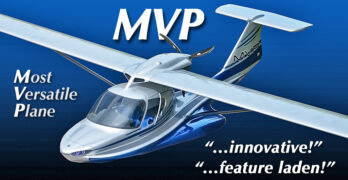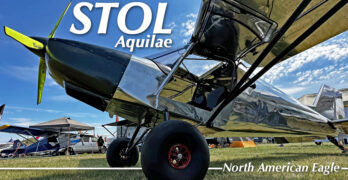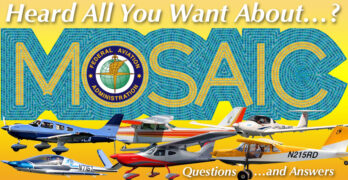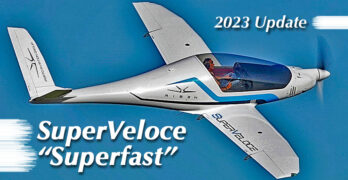The Top 50 video series has gone over very well and continues with this post about the Phoenix LSA motorglider. If you thought it disappeared and were unhappy about that, have I got good news for you!
I am aware of a very positive development regarding Phoenix that I am working to confirm. As soon as I have fuller details I will update this article but the prospects for LSA motorglider look promising.
In North America, Phoenix Air USA is run by Ed Babovec (email) and he is excited about 2024. …more as it unfolds.
Motorgliders as a subset of all aircraft enjoy some very special privileges that endear them to the recreational flying community. In particular, motorgliders do not require an aviation medical. That alone makes them desirable but long-gliding capabilities make them safer to some pilots and simply more enjoyable to others. Let’s look a little more deeply.
Search Results for : CT AND hand control
Not finding exactly what you expected? Try our advanced search option.
Select a manufacturer to go straight to all our content about that manufacturer.
Select an aircraft model to go straight to all our content about that model.
First One in the USA — Flying TL’s Luxurious, Mosaic-Ready Sparker Aircraft
Some pilots can hardly wait for Mosaic. It takes all kinds, of course.
Many aviators want to use Sport Pilot’s no-medical aspect to fly a Cessna or Piper that they can buy inexpensively (or already own). That makes sense. These affordable aircraft are familiar and proven, even if they are products of the 1950s with mostly analog instruments and powerplants that burn 10 to 15 gallons per hour of 100LL.
Another group, owners of modern LSA, wants a little more weight than allowed by current regulation. Still others may want to fly at night or in IFR or to use an economical LSA for some form of aerial work.
Then we have what I’ll call the Mosaic LSA crowd. These are pilots with larger budgets — perhaps they sold a Cirrus or Bonanza and have equity to put toward a new aircraft. These experienced pilots are accustomed to well-equipped aircraft with generous cruise speeds.
Keeping Aircraft Affordable, Blue Collar Aviation Has a Flying Machine for Everyman
Tabor Coates calls his business Blue Collar Aviation. Honestly, as someone who scours the globe for affordable aircraft, any business with this name was certain to grab my attention.
This isn’t simply adroit marketing. Tabor’s Maynard, Massachusetts operation is deep into affordable aviation. How affordable? Tabor’s most-expensive offering is the SkyRanger Nynja (featured in this 2023 article and this flight report). With every item needed in the kit to include engine, instruments and coverings that need no paint, this tried-and-true light aircraft sells for $65,000 and that even includes freight from across the Atlantic.*
How deep into affordable goes Tabor? He offers two versions of SkyRanger — Swift III and Nynja — with a complete kit for the former starting at $49,985. If that’s still high for your budget Tabor offers FlyLight’s line of superlight (nanolight?) weight-shift trikes. The simplest of these flying machines are ready-to-fly for around $15,000.
LSA Pilot Review of a Multicopter: Lift Aircraft’s Part 103-Eligible Hexa
Ready or not, new flying machines are headed our way. Correction, they are already here and a wave of similar entries could follow (see earlier reports). The earliest market-ready arrivals qualify under FAR Part 103.
I believe this website needs to report these aircraft, so with pleasure, I announce the following to be perhaps the first multicopter pilot report from “one of us.” Scott Severen is a longtime LSA pilot, the importer of Jabiru aircraft, and the newly-elected President of LAMA, the Light Aircraft Manufacturers Association. Scott offers his impressions as one of the very first non-company pilots to fly one of these aircraft.
Some call them multicopters (me). Some prefer eVTOL. C’mon, have you said a mouthful like “eVTOL” to any non-pilot? …or even to most pilots? They look at you blankly, “Huh?” Marketers of these aircraft have yet to settle on a catchy word to identify them.
Vickers Aircraft Claims a “World First” as their Wave LSA Seaplane Completes Flight Testing
“Vickers has achieved what others only dream about… a ‘World-First’,” the New Zealand LSA seaplane developer announced. The southern hemisphere company was reporting on the completion of their flight testing program.
“Wave performed exceptionally well, so well in fact that we believe we may have achieved a world-first, a 100% score, passing all criteria and requiring zero changes,” stated company CEO Paul Vickers. He suggested this achievement shows the prototype “is perfect and can enter production,” adding that fabrication of first components is underway.
Although in development for more than a decade, Vickers has indicated all along that their care in design would lead to a quickly approved product that could enter production quickly. The company appears to be reaching this goal.
Test Pilot Report
“In conducting our Flight Test Plan on the Vickers Wave proof of concept, an evaluation was made of the plane’s adherence to ASTM Light-Sport Aircraft industry consensus standards as accepted by FAA,” reported flight test pilot, L.
Top 50 Video: MVP — “Most Versatile Plane” LSA Seaplane Entry
Long before “Mosaic” was a term anyone used*, one airplane stood out for its highly-original design, innovative features, and amazing versatility. Welcome to the once-wonderful world of MVP, the Most Versatile Plane. I am featuring this aircraft as part of an on-going series of our Top 50 Videos (of 1,500) on Dave Loveman’s Light Sport and Ultralight Flyer YouTube channel.
The bad news is… MVP never made it to market, a shame… yet despite heroic fund-raising efforts, sufficient support never materialized.
The good news… other designers observed what MVP offered. Around the time MVP was actively fund raising, Vickers Aircraft down under in New Zealand had begun work on their Wave that is now nearing market release. Icon’s A5 was already mostly frozen for design but some European entries later showed innovations first promoted for MVP.
Developer Darrell Lynds scoured the world for investors. I went with him and other aviation pioneers to China in 2017 where Darrell worked non-stop trying to raise money.
Latin for Eagle, Aquilae is A New Kit Entry in the STOL space from North American Eagle
Let’s get that name dealt with right away — say “ACK-will-lay.” The model name looks more awkward than it is and sounds more graceful than it looks. The word translates from Latin as Eagle. Though unusual, Aquilae is a worthy name for a light aircraft.
When you glance at the photos nearby, do you get the feeling you’ve seen this before? You should, but you may be wrong.
Popular Design Configuration
Aquilae looks very much like but is not the G1 STOL seen earlier (see this article). Some years before G1 arrived here in America, I’d written about French-produced version after seeing it equipped with hand controls and with its wings folded compactly on a trailer at the German Aero Friedrichshafen show. The basic design has been flying for close to 25 years.
Originally developed as the Yuma by Alisport, a French company, the design was later taken over by G1 Aviation, another French company that does extensive machine shop work for several aircraft builders.
Got Mosaic Fatigue? — Comments on FAA’s New Regulation from Two Presentations
I don’t know about you, but I can guess that Mosaic Fatigue is setting in to a lot of quarters. Some pilots have done an extraordinary job of digging into this 318-page document to distill essential parts that need to be addressed. Many pilots get exhausted just looking at the NPRM. …Me, too.
I look forward to more reporting on aircraft. Nonetheless…
Mosaic has given us an inside look at how FAA works. Many improvements resulted when industry worked in harmony with government officials. Nonetheless, careful study found areas of concern in the NPRM. Recent articles in other publications hit essentially the same points as I did in my talk (slide). Those points were partly my thinking, but I also relied on other experts to whom I had posed a variety of questions.
Still, some of the best commentary has come from non-experts, regular pilots who were concerned about a certain part of the NPRM and explored it thoroughly.
Air Taxi or Air Funster? — 5 Models in Development, as Part 103 Multicopters Not Taxis
If you listen to perpetually-excited media, air taxis will soon be shuttling people hither and yon in all the big cities of the globe. Executives and shoppers will be whisked around downtown skyscrapers silently, quietly, swiftly, and the cost will be modest. Do you buy all that? I’m not holding my breath.
Oh, these air taxi vehicles are coming. I don’t doubt that, if for no other reason than they are absorbing vast amounts of money as people bet on some grand future where infotech merges with aviation to make flying vastly better and easier. It’s a fantastic dream and when smart people powered by enough money work on something long enough… something often happens.
Fine. That’s the sales pitch and apparently it’s working because more than 350 companies around the globe have raised billions of dollars to pursue their dreams yet the first entries remain far from market.
Several people at the very pinnacle of FAA have departed the agency and are now working for air taxi developers (naturally, they are often called by some term other than the mundane “air taxi” label).
Streaking through the Sky — Speedy Risen Continues our Top-50 Aircraft Series
When this series started, Icon’s shapely A5 LSA seaplane topped the list. Handsome as it is and like most seaplanes, A5 is not particularly fast. The subject of this second in the series of 50 aircraft is Porto Aviation’s Risen. You might say it is on the other end of the speed spectrum Risen rips!
This one challenges all others in the speed contest for LSA (and later, mLSA).
Our #2 video on Videoman Dave’s immense library has garnered 700,000 views. That’s particularly satisfying as Dave was able to use footage from my first solo video effort.
I was at Aero Friendrichshafen 2015 when Risen made its debut. Videoman Dave was not able to attend that year but I hit it off with developer Alberto Porto and he consented to work with me. I was just learning how to shoot a video so for this one to go over well speaks loudly about how much pilots love Risen.
- « Previous Page
- 1
- …
- 17
- 18
- 19
- 20
- 21
- …
- 61
- Next Page »


